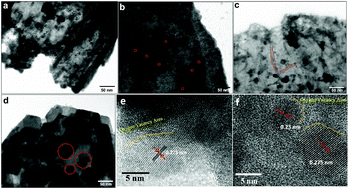Regulation of surface plasmon resonance and oxygen vacancy defects in chlorine doped Bi–BiO2−x for imidacloprid photocatalytic degradation†
Abstract
In this work, chlorine doped Bi–BiO2−x (Cl–Bi–BiO2−x) was prepared by a one-step solvothermal method using sodium bismuthate (NaBiO3·2H2O) as a Bi source without the addition of a surfactant. Both time and temperature of solvothermal reaction may regulate the amount of Bi0 deposition in the photocatalyst, causing surface plasmon resonance (SPR) and oxygen vacancy defects (OVDs). The synergistic effect of SRP and OVD promotes the separation of photogenerated electron–hole pairs, shortens the bandgap, and enhances the optical absorptivity. Imidacloprid, a widely used insecticide, was selected to explore such photocatalysts with controlled OVD and SPR for potential application in pesticide photo-degradation in aqueous solution. Cl–Bi–BiO2−x with a rationally coordinating OVD and SPR shows a narrower band gap, wider light absorption, higher separation efficiency of photo-generated charges and faster pollutant degradation, supporting a green method to synthesize bismuth-based photocatalysts and facilitating the study on the synergistic effect of SPR and OVD on photocatalysts.



 Please wait while we load your content...
Please wait while we load your content...